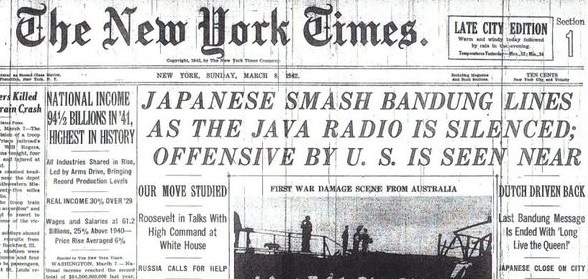
March 9, 1942 saw the unconditional surrender of all Dutch and Allied forces fighting in the Dutch East Indies. However, a number of stubborn characters simply refused to accept it was all over. Feeling that there was still a lot of war to fight they searched for a way to escape before the Japanese could clamp down on them. But how do you escape from an island, 1630 miles ( 2600 km) from Australia… ?
By airplane of course!
And a few desperate attempts succeeded.
The first of these was carried out by an American pilot called Cherymisin and a Dutch lieutenant (S.J. Kok) during the night of March 4/5 1942.
The two of them fuelled up a Boeing B-17 that had been abandoned by the USAAF at Andir (Bandung) airfield and managed to get airborne though neither of them had ever flown this type of aircraft before! After a 10 hour flight they put down at Darwin and reported for duty…
The second notable (and successful) attempt was carried out by a larger group. They too found an abandoned bomber, this time an old Glenn Martin B-10 (or model 139). The bullet riddled airplane was hidden in one of the Andir airfield dispersals. Lieutenant Pieter van Erkel gave it a brief inspection and found that, although the fuselage was badly bullet holed, the engines were OK and the aircraft was fully fuelled.
On the evening of March 8, a small group assembled under the wings of that old bomber, serialled M-585. Pieter van Erkel was there, as well as fellow pilot Bertie Wolf (and his young wife Thea), Captain Simon Spoor and five others.
After topping off an extra fuel tank they started the engines and took off from Andir around 00.50. Thanks to a strong tailwind they reached Broome after seven hours, with barely enough fuel left in the tanks for 30 minutes. The only thing they really had suffered of during that long and uncomfortable flight was the ice cold wind that penetrated through the countless bullet holes and howled around in the airplane…
Glenn Martin M585 was actually taken into USAAF service as a “General’s Jeep’ and re-serialled 42-68358….
The last, and to me most spectacular escape flight took place between March 9 and March 11. Five men flew a Lockheed 12 ‘Electra Junior’ all the way from Java via Sumatra to Ceylon (Shri Lanka)
When Ensign Fred Pelder, a Dutch Brewster Buffalo fighter pilot, heard the news about the capitulation in hospital he stubbornly decided to escape. After making his way to the Java south Coast, he found a number of abandoned (and heavily damaged) Lockheed 12’s on the Pameungpeuk airstrip. Pelder had trained on these aircraft and knew how to fly them.
At the airstrip Pelder met and teamed up with Plt Off Mendizabal (Canadian), Sgt Stuart Munroe (Australian), Alan Martin (Australian) and Doug Jones (New Zealander) and the five of them started to repair one of the Lockheeds. They had no tools but somehow managed to replace a complete tail section, using coins as screwdrivers…
Their work done, the five of them took off on March 9. They flew all the way up to North Sumatra where they landed at a small dispersal field south of Kota Radja (Now Banda Aché). There they made a hasty refueling stop and got out only minutes before Japanese bombers came and flattened the place.
Once safely out over the Indian Ocean they set a course for Ceylon, with an old school atlas as their only navigational aid …
The island of Ceylon was way beyond the fuel range of the L-12, but the inventive quintet had brought a number of fuel filled wine casks aboard. They had cut a hole in the fuslage wall through which a hose connected the casks to the main tank. And they all took turns during their ten-hour flight to pump fuel into the main tank with a small manual pump…
The Lockheed L12 (serialled L-201) was later taken into RAF service (as LV762) and crashed in July 1944 near New Delhi.
Fred Pelder died in 2000 in his native The Hague…

A Lockheed 12 A, almost similar to the one used to escape from Java. Now exhibited at the National Military Museum Soesterberg



Excellent post!
LikeLike
It would definitely help to put a ‘Search” and “Latest Post” on the side bar of your posts the next time you are in the Settings for Widgets.
LikeLike
The great escape!
LikeLike
Thank you
LikeLike